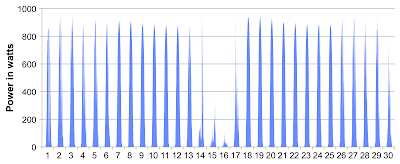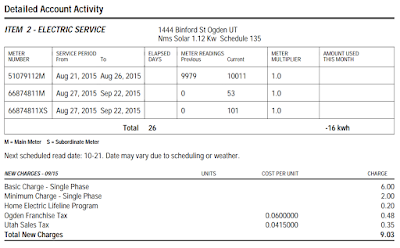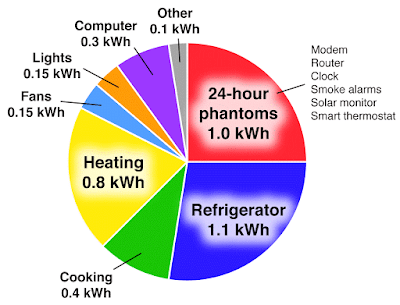Although the days have gotten shorter, the noon sun faces the panels most directly at this time of year—thanks to my steep roof. I can now report that under a clear sky and direct sunlight, the output of my system is typically about 950 watts. That’s the alternating current coming out of the microinverters, as reported by the monitoring system. For comparison, the nameplate rating on the panels themselves is 280 watts each, or 1120 watts total. I’m not sure how much of the difference between 1120 and 950 is due to atmospheric conditions, and how much is due to the losses in the DC-to-AC conversion.
To get an idea of the variability of the power output, you can look at the data on the Enphase Enlighten site. Here’s a plot of all the data from September on a single horizontal axis (click to enlarge):
On my system’s best day so far, September 18, its total energy output was 6.5 kWh. On its worst day, just two days earlier, the output was only 0.3 kWh. Fortunately, I live where the skies are not cloudy all day—at least not very often—so the system is averaging about 5 kWh per day.
I use some of that solar-generated electricity as it comes off the panels, but most of it gets pushed onto the grid for my neighbors to use. Then, at night and at other times when I need more power than the panels are producing, I pull what I need off the grid. The power company’s meter, on the back of my house, separately measures the power flowing in both directions, records both amounts of cumulative energy, and blinks between displaying the two amounts:
By combining the solar monitor data with the net meter readings, I can construct a comprehensive picture of the energy flows through my house. Here’s the picture for the calendar month of September:
Fortunately, the power company (under direction from the Utah Public Services Commission) lets me accumulate credits for energy pushed onto the grid, and apply them toward future months when I’ll use more energy than I produce. Here’s a copy of my first net-metering bill, covering the end of August and the beginning of September:
I’m still getting billed the $6 “basic charge” that everyone pays for being connected to the grid, plus a $2 “minimum charge” for not using any (net) electricity. (So in effect, the basic charge is really $8 and they give you your first $2 worth of electricity for free. That’s not much electricity, but this practice still bugs me.) Add on the taxes and surcharges and my total bill comes to just over $9.
It’s only fair that I have to pay to be connected to the grid, because I really do depend on it. Here, for example, is a detailed plot of my solar production on the best day so far, with my “typical” electricity use superimposed:
(That electricity monitor is the Efergy Elite Classic and Engage hub system, which I installed soon after the solar panels. It’s a marvelous tool, and I really wish I had installed it earlier. But I also wish I had paid another $25 for the version that measures true power, because my microinverters have a nontrivial power factor that fools the Efergy Elite Classic, especially at night. Unfortunately, even Efergy’s “true power” meter apparently can’t measure the direction of energy flow, so it would give confusing data when my solar panels are active during the day. There are competing brands that lack this drawback but I haven’t tried them. In any case, I’ve had to manipulate my Efergy data quite a bit to produce the “typical” usage graph shown above.)
Because I use so much electricity when sunlight is scarce or absent, I can hardly claim that my home is 100% solar powered. I still depend very much on Rocky Mountain Power’s coal- and gas-fired power plants, which are steadily pumping carbon dioxide into the atmosphere and contributing to global warming. Consequently, I don’t consider my solar panels to be a license to waste electricity. Rather, they’ve inspired me to better understand and minimize my electricity use.
Here, then, is an estimated breakdown of my daily household electricity use, averaged over the seasons:
My total household electricity use, as reported earlier, averages about 4 kWh per day. That’s quite a bit lower than the per-capita average here in the U.S., but not so different from most other industrialized countries. Notably absent from my household are such unnecessary luxuries as air conditioning, a second refrigerator or freezer, an electric clothes dryer, a television, or a hot tub.
Not everyone is in a position to invest in rooftop solar panels, but everyone can work to cut their unneeded electricity use—and save money in the process. As Mr. Money Mustache says, “Measure everything, then get angry at waste.”







